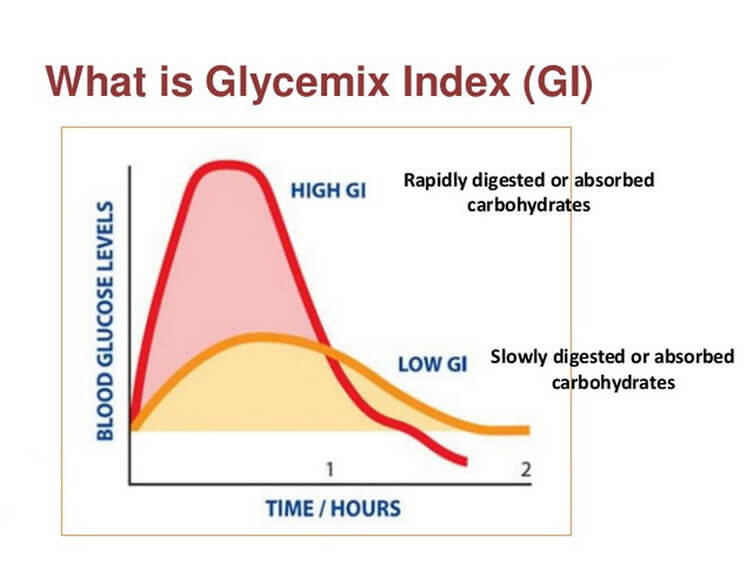Glycemic Index Chart: Glycemic Values of Foods List
It is now known that some simple and complex carbohydrates in foods elevate blood glucose levels more than do others. Carbohydrates and carbohydrate-containing foods are now being classified by the extent to which they increase blood glucose levels. This classification system is called the glycemic index. Carbohydrates that are digested and absorbed quickly have a high glycemic index and raise blood glucose levels to a higher extent than those with lower glycemic index values.
What is the Glycemic index?
The glycemic index (GI) is a number from 0 to 100 assigned to food, with pure glucose arbitrarily given the value of 100, which represents the relative rise in the blood glucose level two hours after consuming that food. The GI of a specific food depends primarily on the quantity and type of carbohydrate it contains; but also is affected by the amount of entrapment of the carbohydrate molecules within the food, the fat and protein content of the food, the amount of organic acids (or their salts) in the food, and whether it is cooked and, if so, how it is cooked. GI tables are available that list many types of foods with their GIs. A food is considered to have a low GI if it is 55 or less; high GI if 70 or more; and mid-range GI if 56 to 69.
Diets providing low glycemic index carbohydrates have generally been found to improve blood glucose control in people with diabetes, as well as to reduce elevated levels of blood cholesterol and triglycerides; increase levels of beneficial HDL cholesterol; and decrease the risk of developing type 2 diabetes, some types of cancer, and heart disease.
Dietary replacement of saturated fats by carbohydrates with a low glycemic index may be beneficial for weight control, Lowering the glycaemic load of the diet appears to be an effective method of promoting weight loss and improving lipid profiles and can be simply incorporated into a person's lifestyle.
Glycemic Index Chart for Common Foods
| Food Name | GI value |
| High GI Foods Chart (70 and Higher) | |
| Glucose | 100 |
| French bread | 95 |
| Scone | 92 |
| Baked Potato | 85 |
| Corn Chex | 83 |
| Pretzel | 83 |
| Rice Krispies | 82 |
| Cornflakes | 81 |
| Corn Pops | 80 |
| Gatorade | 78 |
| Jelly beans | 78 |
| Doughnut, Cake | 76 |
| Waffle, frozen | 76 |
| French fries | 75 |
| Shredded Wheat | 75 |
| Cheerios | 74 |
| Popcorn | 72 |
| Watermelon | 72 |
| Grape-Nuts | 71 |
| Wheat bread | 70 |
| White bread | 70 |
| Medium GI Foods Chart (56–69) | |
| Breadfruit | 69 |
| Orange soda | 68 |
| Sucrose | 68 |
| Taco shells | 68 |
| Angel food cake | 67 |
| Croissant | 67 |
| Cream of Wheat | 66 |
| Quaker Quick Oats | 65 |
| Chapati | 62 |
| French bread with butter and jam | 62 |
| Couscous | 61 |
| Raisin Bran | 61 |
| Sweet potato | 61 |
| Bran muffin | 60 |
| Just Right cereal | 60 |
| Rice, white or brown | 60 |
| Blueberry muffin | 59 |
| Coca-Cola | 58 |
| Power Bar | 56 |
| Low GI Foods Chart (55 and Lower) | |
| Honey | 55 |
| Oatmeal | 54 |
| Corn | 53 |
| Cracked wheat bread | 53 |
| Orange juice | 52 |
| Banana | 52 |
| Mango | 51 |
| Boiled Potato | 50 |
| Muesli | 48 |
| Green peas | 48 |
| Pasta | 48 |
| Carrots | 47 |
| Cassava | 46 |
| Lactose | 46 |
| Milk chocolate | 43 |
| All Bran | 42 |
| Orange | 42 |
| Peach | 42 |
| Apple juice | 40 |
| Plum | 39 |
| Apple | 38 |
| Pear | 38 |
| Tomato juice | 38 |
| Yam | 37 |
| Dried beans | 25 |
| Grapefruit | 25 |
| Cherries | 22 |
| Fructose | 19 |
| Xylitol | 8 |
| Hummus | 6 |